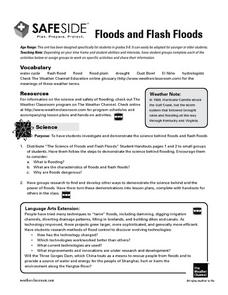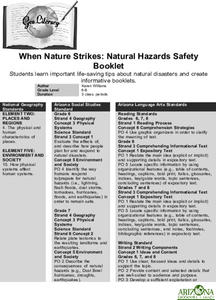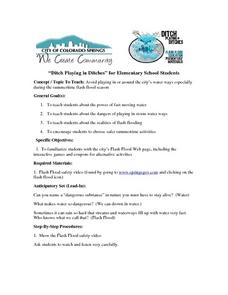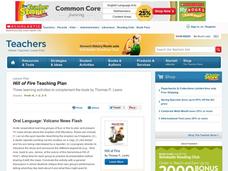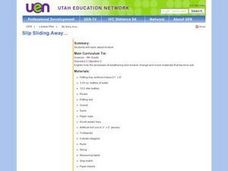Curated OER
Floods and Flash Floods
Junior geologists, hydrologists, or meteorologists simulate what happens during the flooding of a river and demonstrate factors that contribute to flash flooding. This outstanding resource provides a vocabulary list, online resources,...
Curated OER
Flash Flood!
Students study floods and flash floods. The About Floods page explains the difference between floods and flash floods, and why flash floods occur. The Flood Types page explores some of the different types of floods that occur. There is...
Curated OER
Great Rivers 2: The Ups and Downs of River Flooding
Second in a three-part lesson on rivers, this lesson focuses on the flooding that occurs in riparian locations. First, learners take a look at facts about the Amazon River. They read online materials and fill in a worksheet as they...
Curated OER
Floods
Young scholars explore Earth science by answering study questions on-line. In this natural disasters instructional activity, students research Australia flood statistics over the past 40 years and identify patterns. Young scholars...
Curated OER
When Nature Strikes: Natural Hazards Safety
Students observe the impact of natural disasters on humans, and become aware of the dangers of environmental hazards such as flash floods, tornadoes, and hurricanes.
NOAA
Thunderstorms, Tornadoes, Lightning. . . Nature's Most Violent Storms
Thunderstorms, tornadoes, floods, and hail are just a few of the topics covered in a thorough weather preparedness guide. With descriptions of each weather phenomenon, from what causes them to how and when they occur to...
Curated OER
Ditch Playing in Ditches
Young scholars explore about the power of fast moving water and the dangers of playing in storm water ways. They explore the realities of flash flooding and how to choose safer summertime activities. Students become familiar with the...
Curated OER
Water, Water Everywhere
Students estimate the amount of water that can be found in its various forms including oceans, lakes, glaciers, rivers, etc. They view a demonstration about water distribution and discuss flash flooding safety precautions.
Curated OER
Severe Weather is Spring Challenge
Middle schoolers research severe weather history in their hometowns, interview local meteorologist to find out their suggestions for disaster preparedness, inquire as to local school district's emergency plan, and create poster or Public...
Scholastic
Hill of Fire Teaching Plan
Some books are perfect for drawing connections between multiple subjects. The book Hill of Fire becomes the hub for three very different, yet related activity ideas. First the class hones their oral language skills by creating an...
National Park Service
Caves, Canyons, Cactus, and Critters
Mother Nature's Gravel Company is open for business! The unit includes four lessons covering weathering and erosion. Experiments are simple to complete and young geologists compare notes to see who makes the biggest ice...
Curated OER
Storm Protection
In this weather worksheet, students read an excerpt about how to protect yourself, others, and property from various types of storms. There are five short answer questions related to the excerpt that students respond to.
Curated OER
Learning Lesson: Sweatin' to the Coldies
Students participate in a demonstration to show the change of water vapor to a liquid. They discuss the three states of matter. They examine flash flood safety to end the instructional activity.
Curated OER
Learning Lesson: Atmospheric Collisions
Students participate in a demonstration showing how rain drops grow by coalescence. They use ping pong balls and put them in an air stream. They end the lesson discussing flash flood safety.
Curated OER
Severe Weather
Fifth graders identify the causes and effects of several different kinds of
severe weather phenomenon. They read an excerpt from John Muir's book The Mountains of California and research one of the following severe
weather phenomena...
Kenan Fellows
Making Connections with Water Quality
What's in your water? And, why is water quality so important? Enhance your class's level of water appreciation through a lesson that demonstrates the necessity of water quality. Environmental enthusiasts explore the EPA's Clean Water...
Curated OER
Swamps, Shrimp, and Tsunamis: A Simulation of Sustainable Development Issues in Coastal Ecuador
Students examine the economic benefits, environmental losses and dangers of the shrimp farming industry on the coast of Ecuador. They read a script, role-play people involved in the shrimp business, and write an essay of the pros and cons.
Curated OER
Twister Season Springs into Action
Young scholars discover how weather conditions can give rise to severe storms and tornadoes. They study the different types of severe weather, how they can track conditions in their own neighborhood, and how to prepare for the worst.
Curated OER
Erosion: Slip Sliding Away
Fourth graders investigate the causes of erosion. Through several demonstrations including one using sugar cubes and warm water, they observe the effects of erosion. In groups, 4th graders conduct similar experiments and record their...
Curated OER
Myths and Legends on Natural Disasters: Making Sense of Our World
Students explore different natural and manmade disasters through a webquest. In this earth science lesson, students explain their causes. They also discuss how disasters affect society.
Curated OER
Make A Thunderstorm!
Students create a thunderstorm by putting ice cubes and food coloring into a container and observe what happens to the food coloring. In this thunderstorm lesson plan, students discuss the cause and effects of thunderstorms and then...
Curated OER
Electricity: Static and Current
Students investigate static and current electricity. In this electricity lesson plan, students observe 4 demonstrations and conduct 3 activities to explore the repulsion of electrons and the attraction of protons and electrons. They...
University Corporation for Atmospheric Research
Ucar: Flash Floods Teaching Box
This teaching box is filled with explorations and readings that help secondary students learn the science of flash flooding.


